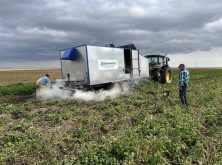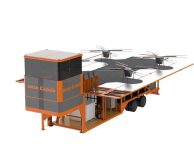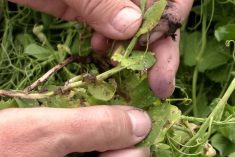Prairie farmers are well known for their hospitality but there’s one visitor they want nothing to do with — kochia.
Kochia has become one of the most problematic weeds in Western Canada. A single kochia plant can produce up to 25,000 seeds and can achieve a germination rate of 60 per cent or higher depending on temperatures.
Perhaps even more troubling is the fact that kochia is showing increasing resistance to many herbicide groups. A study conducted in Alberta five years ago showed it to be nearly 100 per cent resistant to Group 2 herbicides. The same study showed 50 per cent of the kochia weed population in that province to be resistant to Group 9 herbicides. And, more recently, it has shown a growing resistance to Group 4 herbicides (18 per cent).
Read Also

Claas brings 1000 Series SP forage harvesters to Canada
In mid-August, Claas unveiled its new line of Jaguar forage harvesters at an event in Visalia, California, deep in the heart of that state’s dairy region.
“Kochia is really good at being a weed,” says Graham Collier, portfolio manager for Nufarm Agriculture’s Calgary operations.
“It has all of these characteristics that make it a good weed — it germinates early, it can grow in places where nothing else grows and it’s excellent at spreading and setting seeds. It’s really important growers manage it every year. If it gets away for even one year, you will battle it for the next decade, if not longer. It requires a concerted effort to manage kochia on your farm.”
- [READ MORE] How to scout for herbicide-resistant weeds
A major reason kochia is so difficult to control is it’s primarily a cross-pollinated species. That means if a single plant sheds 25,000 seeds, it can potentially produce 25,000 new plants with each one having a different genetic makeup from the rest, giving it a huge advantage against most herbicide solutions, Collier explains.
“You’ve got this great genetic variation among a kochia population that gives it this ability to come up with answers to herbicides,” he adds.

Another important consideration with kochia is it has a short seed bank longevity. That means, even if growers spray their fields for kochia, they may only be eliminating the plants that are herbicide susceptible. Those tolerant or resistant to herbicides will put seed in the ground and are likely to germinate the following season with minimal susceptible kochia remaining. As a result, kochia populations can rapidly evolve from susceptible to resistant.
“The shorter your seed bank, the faster your weed population shifts from being mostly susceptible to mostly resistant,” Collier says.
Still not convinced that kochia deserves its own most wanted poster? Then consider this — it’s not fussy about where it grows and can flourish in almost any conditions, even though it prefers hot and dry climates.
“I’ve toured some fields in southern Alberta where (farmers) just literally do not have a good herbicide option to control (kochia) anymore. The management decisions on their farms are completely based on trying to overcome severe kochia populations,” Collier recalls.
While kochia poses a threat to almost any kind of crop, it’s particularly problematic when it comes to pulse crops such as peas or lentils. Collier says that’s because kochia is essentially 100 per cent resistant to Group 2 chemistries (ALS inhibitors), which just happen to be the primary weed management option for most pulse crops. For pulse growers, this has resulted in a shift in the management of kochia, he adds, as they are now trying to manage kochia before their crop goes in the ground with pre-emergent herbicides and burn-down herbicide applications.
Situation not hopeless
Despite the seriousness of the risk posed by kochia, the situation is far from hopeless, says Collier. He says there are multiple actions growers can take to mitigate the effects of kochia on their crops.
The first thing farmers can do is to manage the kochia populations on their farms as if those populations are herbicide resistant, even if they haven’t yet seen evidence of that.

“You may not necessarily think you have glyphosate resistance on your farm, but you should manage your kochia population like you do,” he says.
“If you do that, it greatly reduces the risk of that resistance showing up on your farm if it’s truly not there, or it reduces the spread of it if it is there. It costs a little bit more and it takes a little bit more effort to manage it like you have resistant kochia, but it saves an awful lot of money and trouble in the long run if you can keep it out of your field.”
Collier also recommends using optimum seeding rates to increase crop competition and herbicide products or tank mixtures with multiple modes of action, often referred to as layering, as part of an effective kochia management strategy.
“Never just use glyphosate alone or Group 2 alone. Always use combinations of groups that work on kochia,” he says. “You have to use herbicide active ingredients that still work on your kochia and use multiple groups at once. By mixing multiple modes that work still, you greatly reduce your selection pressure for resistance on any one mode of action.”
Collier’s last piece of advice on how to slow the spread of herbicide-resistant kochia is to keep it guessing. That means changing up weed management strategies on a regular basis, rather than sticking with methods that worked in the past.
“Weed populations love predictability. You need to keep them off-kilter. If you do the same thing at the same time every year, their populations will shift around that selection pressure,” he says.
“It’s important that you change the times you are trying to control that population. If I spray my field on June 15 every year, I’m going to select for plants within the population that germinate and emerge earlier and are harder to control when I apply my herbicide, or emerge later, after my herbicide application. A good crop rotation is the easiest way to change up the timing of herbicide applications and the onset of crop competition with weeds. Different herbicide options like soil-applied residual products also help to change up what your kochia population is expecting.
“That’s why residual herbicides completely change things because you are attacking (the weeds) as they come out of the ground. Burn-down herbicides also change that because you’re attacking them when they first emerge and are very small. Either of those two things then take pressure off of your in-crop application because there are fewer smaller weeds when you go in there with your in-crop herbicide.”
















